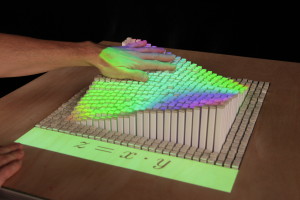Advances in digital fabrication and material sciences have enabled physical 3D displays: shape-changing devices for computer-supported, physical representations of data (Data Physicalizations) [2]. These artefacts exploit users’ rich visual and tactile senses providing enhanced support for cognition, communication, learning, problem solving and decision making. When combined with shape-change, such artefacts can then support adaptation to different data types and datasets. Examples of devices which enable such physical representations of data include Lumen [3] and inForm [1] which consist of arrays of actuated rods which can move up and down, creating faux 3d reliefs. These displays are also prominent in SciFi narratives, as seen in the screenshots taken from X-Men (Top Figure).

Lumen
1. Sean Follmer, Daniel Leithinger, Alex Olwal, Akimitsu Hogge, and H Ishii. 2013. inFORM: dynamic physical affordances and constraints through shape and object actuation. Uist: 417–426. http://doi.org/10.1145/2501988.2502032
2. Yvonne Jansen, Pierre Dragicevic, Petra Isenberg, et al. 2015. Opportunities and Challenges for Data Physicalization. Proceedings of the 33rd Annual ACM Conference on Human Factors in Computing Systems – CHI ’15, ACM Press, 3227–3236. http://doi.org/10.1145/2702123.2702180
3. I Poupyrev and T Nashida. 2004. Lumen: interactive visual and shape display for calm computing. ACM SIGGRAPH 2004 …: 2. Retrieved May 19, 2014 from http://dl.acm.org/citation.cfm?id=1186173

